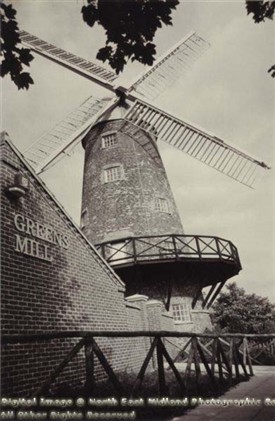Sneinton: A general history

Green's Mill Sneinton
www.picturethepast.org.uk
History, landmarks and famous people
Originally a Saxon settlement, Sneinton remained a small village until the early 19th century when the area saw major developments including a programme of house building to accommodate people employed in the factories and workshops that were springing up in the area.
Sneinton had a socially mixed population living in a variety of houses ranging from small back to backs, modest terraced housing and larger, more genteel dwellings.
Originally, the dominant local industry was bobbin net making and framework knitting but later this diversified into lace making, machinery manufacture and malting.
During the first half of the 20th Century many of the older houses were demolished to make way for new housing.
In May 1941 many buildings in Sneinton were destroyed or damaged in an air raid.
In 1975 the area of the old village of Sneinton became a conservation area and Green's Windmill, which was derelict, was restored to working condition and later became a museum.
Notable Sneinton buildings and landmarks include:
Green's Windmill
The windmill at Sneinton was built in 1807 by George Green, a local grain merchant. It is one of the earliest examples of a brick built windmill in the country. And worked producing flour and animal feed until the 1860's. The mill then fell into disrepair, finally being burnt down in 1947.
The shell was bought by the George Green Memorial Society and given to the City of Nottingham in 1979. It was restored during the 1980s as a museum and science centre and started milling again in 1986.
For more information visit the Green's Mill website.
St Stephen’s Church
There has been a church on the same site since earliest times. The current building, the fifth recorded, has a tower dating back to the 1839 church and a chancel, transepts and nave dating from the rebuilding of the church in 1909/1912.
Sneinton Hermitage
Today there are only a few small caves remaining where, in former times many people lived in houses with brick built fronts that were built into the rock incorporating the caves into the living space. Railway and road development in the late 19th Century saw the area much changed, with many of the caves destroyed.
Some famous people with Sneinton connections
George Green Mathematician
Son of George Green the grain merchant and builder of the Sneinton windmill. Originally employed in the family business, George became a mathematician, publishing his first book in 1828. In 1833 he left Nottingham with his family and eventually became a Fellow at CambridgeUniversity.
He became ill and returned to Nottingham and died there in 1841.It was after his death that the true extent of his mathematical genius was recognised with "Green's Functions" still in use.
William Booth Founder of the Salvation Army
Born in 1892 in Notintone Place, Sneinton, William Booth was the son of a builder and, on leaving school, worked at a pawnbrokers. He became involved with the Wesleyan Methodists and during the 1840's preached in the slums of Nottingham, building up a band of followers.
In 1849 he moved to London and then travelled around the country on behalf of the Methodist church whose ministry he eventually left.In 1865 he returned to London with his wife and family and founded the East London Christian Mission which was to become the Salvation Army.
William Booth received the Freedom of the City of Nottingham in 1905. He died in 1912. There is a museum dedicated to him at Notintone Place.
For more information visit the William Booth Birthplace Museum website.
This page was added by
H W on 31/07/2012.